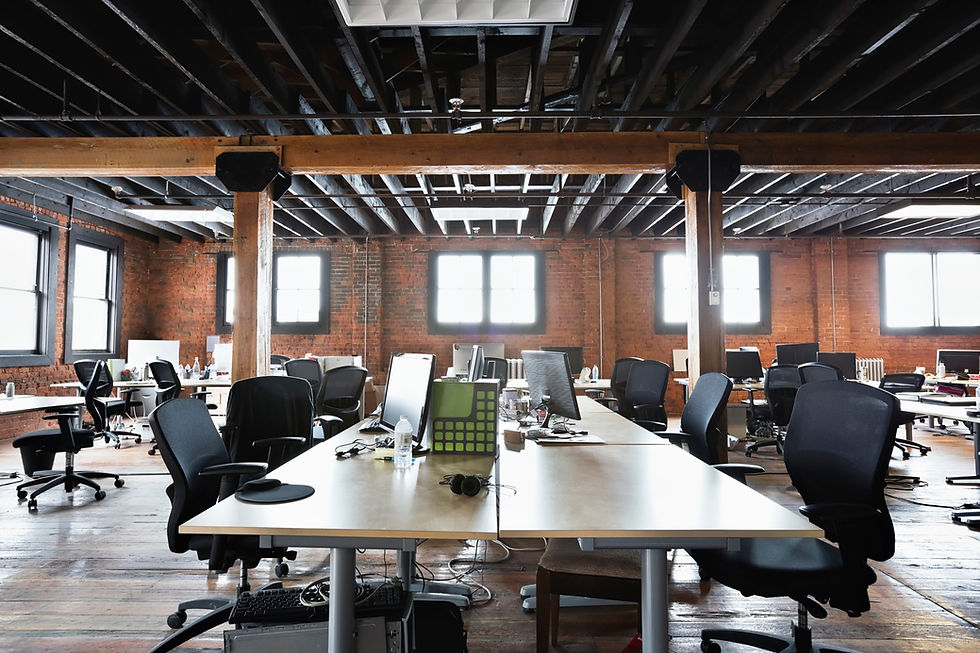The rise, fall and resurrection of cubicles
- The Eggleston Group

- May 25, 2024
- 3 min read

The origins of cubicles trace back to Frank Lloyd Wright and other early 20th century architects and designers. They believed that walls made offices dreary, dungeon-like places that made workers feel trapped. Business owners tended to agree, but for different reasons. They believed walls inhibited the ability to pack as many workers into one place as possible to maximize productivity and profits. Enter cubicles.
Robert Probst was head researchers at office furniture manufacturer Herman Miller in the 1960s. His goal was to create a work environment that afforded workers more privacy and autonomy. The typical 1940s and 1950s office consisted of rows of separate desks, like you'd see in an elementary school classroom. Meanwhile executives and managers had private offices with doors, creating a clear hierarchy in the office. Everyone else endured noise from typewriters and clouds of cigarette smoke all day, while executives basked in virtual luxury.
German offices started deviating from traditional desk setups in the 1950s. They used office partitions to create some semblance of privacy and autonomy for workers. They called it the "office landscape" (Bürolandschaft) system. Probst took things a step further. He not only created partitions between desks, but also customized work surfaces, desk heights and sizes. He called this modular seating system "action office."
Action Office II

The Action Office provided a system of standing and sitting desks, along with filing systems, that streamlined the overall working environment. Dividers provided privacy and helped muffle noise around each worker. This system worked great for small companies with 10 or fewer workers. It was not ideal for large corporations with hundreds or thousands of workers under one roof.
Probst introduced Action Office II in the late 1960s. It accommodated an ever-changing office environment without having to fundamentally redesigning or changing the layout. It particularly addressed high turnover and preparing new spaces for new employees. Probst's research told him that workers were more productive when there was some semblance of territory, of their own private, personalized space. Three-sided walls around desks made this possible, while also facilitating communication with surrounding colleagues.
All components were interchangeable. Workers customized workstations as they saw fit. Modern cubicles were born.
Cubicles 1970s to 1990s
Cubicles were so ubiquitous by the 1980s that their social impact reached far beyond the office. Dolly Parton, Lily Tomlin and Jane Fonda brought cubicle culture into American homes with the 1980 hit film "9-5." Scott Adams began publishing the comic strip "Dilbert" in 1989. It satirized office and cubicle culture. The 1999 comedy film "Office Space" didn't do great at the box office. But it is now considered a cult classic.
The 21st century introduced internet, social media and smartphones to the public. Cubicles remained a big part of office culture through most of the early 2000s. But an increasingly younger workforce, along with technological advances, ushered in change.
Open office workstations

Cubicles fell out of favor with Human Resources personnel and business owners about 15 years ago. They believed walls and dividers discouraged collaboration. Open office workstations exploded onto the scene in the mid-2000s and took over as the office cultural norm. Facebook headquarters in Menlo Park is the largest open office workspace in the world.
Employees never truly embraced open office layouts. Several Apple engineers threatened to quit when the company announced its new open office plan. These layouts also had the reverse effect of their intent. A Harvard study found that face-to-face interactions fell by 70% when companies switched to open office plans. Electronic communications (emails, texts, etc.) also increased as a result of open office. Despite mixed results, companies steadfastly held onto open office. That is until COVID-19.
Return of the cubicle
The novel coronavirus has infected 1.74 million Americans as of publishing, with 90,000 said infections in California, according to government data. Most of the country is lifting it's shelter-in-place orders after nearly nine weeks. Many workers are still telecommuting or furloughed. When workers do return to the office, things will be very different.
The Eggleston group has been open throughout the shelter-in-place directive, providing essential services to Texas businesses. We are retrofitting cubicles with plexiglass safety barriers and providing office partitions to facilitate social distancing in open office settings. We can retrofit your cubicles with plexiglass barriers with 7-14 day turnaround times. Give us a call today 469-324-5600 to prepare your office for a safe reopening.




Comments